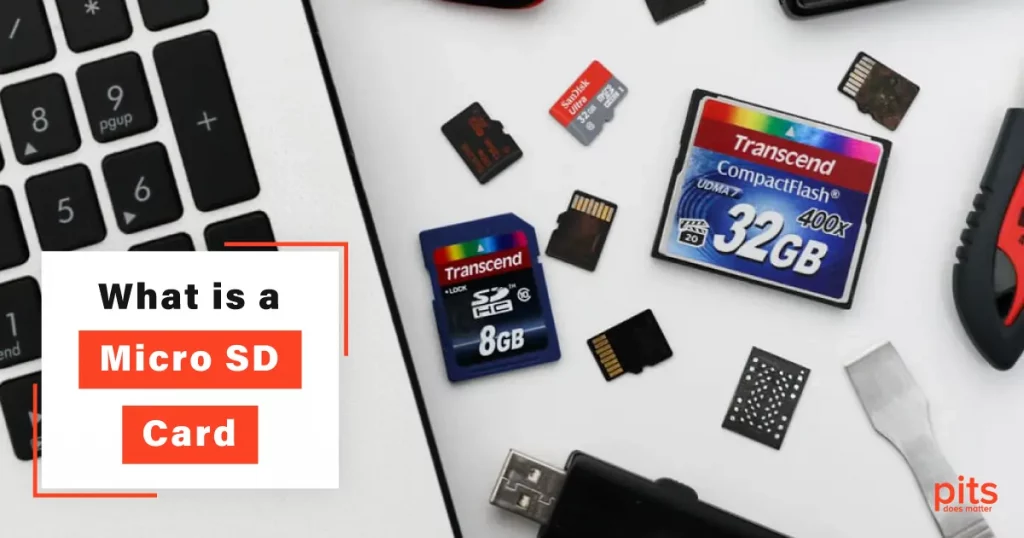Micro SD cards have revolutionized how we store, transfer, and access data in the rapidly advancing world of technology. Our data storage needs have grown exponentially from full-sized SD cards to the compact Micro SD format. In this blog post, we will explore the evolution of Micro SD cards, their advantages and disadvantages, applications across various devices, and the critical aspect of SD card speeds. By the end, you will have a deeper understanding of this versatile storage solution and how it impacts our daily lives.
Understanding Memory Card Formats
Memory card formats are portable storage devices used to store and transfer data across various devices, including smartphones, cameras, drones, gaming consoles, and more. The two primary formats are full-sized SD cards and Micro SD cards, both of which use flash memory technology to store data securely.
Full-Sized SD Cards: The original Secure Digital (SD) card format, standardized in 1999 by the SD Association, revolutionized digital storage. These cards typically measure 32 x 24 x 2.1 mm and are commonly used in digital cameras, camcorders, and laptops.

As technology evolved, the demand for more compact and versatile storage solutions arose, leading to the development of Micro SD cards.
Micro SD Cards: The Micro SD format, introduced in 2005, is a smaller version of the standard SD card. Measuring only 15 x 11 x 1 mm, these tiny cards are ideal for smaller devices such as smartphones, tablets, action cameras, and gaming consoles. Micro SD cards are backward compatible with standard SD card slots through the use of SD adapters.
The Birth of Micro SD Cards
The development of Micro SD cards was driven by the increasing need for high-capacity storage in mobile devices. As smartphones became more powerful and feature-rich, users required additional storage space to accommodate photos, videos, apps, and other data. Micro SD cards filled this void perfectly by providing a compact and reliable storage solution.

Advantages of Micro SD Cards
Micro SD cards come with several advantages that have contributed to their widespread adoption:
- Compact Size: The most apparent advantage of Micro SD cards is their compact size. Their diminutive dimensions allow them to fit seamlessly into slim smartphones, drones, action cameras, and other portable devices.
- High Capacity: Despite their small size, Micro SD cards offer impressive storage capacities. They are available in various capacities ranging from a few gigabytes to multiple terabytes, catering to the needs of both casual users and professionals.
- Versatility: Micro SD cards are versatile and can be used in various devices with an SD card slot. With the help of SD adapters, these cards can be used in full-sized SD card slots, making them compatible with a wide range of devices.
- Expandable Memory: One of the most significant advantages of Micro SD cards is their ability to expand the memory of compatible devices. This flexibility allows users to upgrade their storage space without having to replace the entire device.

- Easy Data Transfer: Transferring data between devices is made seamless with Micro SD cards. Users can easily move files from their smartphones to computers or other compatible devices without the need for complicated cables or software.
Disadvantages of Micro SD Cards
While Micro SD cards have numerous advantages, they are not without their drawbacks:
- Slower Speeds: Compared to full-sized SD cards, Micro SD cards may have slightly slower read and write speeds, particularly in lower-end models. This can affect performance when dealing with large files or during continuous data recording.
- Vulnerability to Loss: Micro SD cards are more prone to misplacement or loss due to their small size than their larger counterparts. To avoid this, users must handle these cards carefully and consider using protective cases.
- Limited Lifespan: Like all flash memory cards, Micro SD cards have a limited number of read and write cycles. Frequent and intensive data operations can reduce their lifespan over time.
- Compatibility Issues: In some cases, certain devices may not support Micro SD cards or may require a firmware update to use higher-capacity cards.
Understanding SD Card Speeds
SD card speeds are an essential factor to consider, especially when dealing with high-definition media and demanding applications. The speed class rating and various speed classes help determine the card’s performance capabilities.
Speed Class Rating: The Speed Class rating identifies the minimum sustained write speeds of an SD card. The SD Association has defined four standard Speed Classes: Class 2, Class 4, Class 6, and Class 10. Each class represents the minimum MB/s (megabytes per second) write speed the card can achieve.
Ultra High-Speed (UHS) Speed Classes: For faster data transfer, UHS-I and UHS-II speed classes are available. UHS-I cards can achieve higher data transfer rates compared to traditional Speed Classes, while UHS-II cards offer even faster speeds suitable for professional use.
Application Performance Class: The Application Performance Class (A1 and A2) was introduced to assess the card’s random read and write capabilities. A2 cards offer improved performance, making them ideal for running applications directly from the memory card.
Micro SD cards have revolutionized the way we store and access data in a wide range of devices, from smartphones and cameras to gaming consoles and drones. Their compact size, high storage capacity, and versatility have made them an indispensable component of the modern digital landscape. While they have some limitations, the advantages of Micro SD cards outweigh the disadvantages. With technological advancements, these cards will continue to play a vital role in our daily lives. As our storage needs evolve, manufacturers will undoubtedly push the boundaries of Micro SD cards, offering even higher capacities and faster speeds to cater to our data-hungry world.
Micro SD Card Data Recovery with PITS
Retrieving files from a Micro SD card can be complex and delicate, demanding expertise and careful handling. These tiny cards hold valuable data, and each step taken during recovery carries significant consequences.
At our company, we recognize the vital importance of your data to our customers. Therefore, we go the extra mile to achieve the best possible recovery results. Employing precise tools and operating within an ISO Certified Class 10 Cleanroom environment, we ensure your device remains safe. This controlled setting guarantees that your delicate Micro SD card is shielded from damage caused by humidity, dirt, or dust. Here are the other benefıts of PITS Global Data Recovery Services:

If you’re facing a data loss situation, don’t hesitate to contact us. Our 24/7 data recovery services are available to you, 365 days a year. Let us help you recover your precious data today.

We start the recovery process with a risk-free evaluation. Our technicians estimate reasons for data loss and the level of damage. Based on it, we select the most suitable recovery strategy.

With years in the data recovery industry, our company supports the highest customer satisfaction rate. We do everything to provide a positive experience for our clients.

During our remote customer file verification session, you will thoroughly review all necessary documents and records to ensure accuracy and compliance.

We offer data recovery services from over 50 locations across the US. This means that no matter where you are located, you can access our services to recover the data.

With our certified data recovery services and 99% success rate, we are confident that we can recover your precious data and get you back up and running in no time.
In addition to our data recovery services, we offer customers a technical assessment to facilitate the handling of failure situations. If you observe any signs of failure, such as your Micro SD card not being recognized or missing files, promptly send it to our data recovery lab. Our skilled technicians will conduct a thorough evaluation to identify the root cause of the malfunction and assess the extent of the damage.
Damaged Micro SD cards can lead to a myriad of problems, but with our team of specialists, you can leave those worries behind. Our dedicated services ensure that all these issues are expertly resolved, and you can trust us to successfully retrieve your deleted files.
Frequently Asked Questions
What is a Micro SD card?
A Micro SD card is a small, portable storage device used to store and transfer data in various electronic devices like smartphones, cameras, drones, and tablets. It is a compact version of the standard SD card and is about the size of a fingernail.
How do I insert a Micro SD card into my device?
To insert a Micro SD card, locate the card slot on your device. Gently push the Micro SD card into the slot until it clicks into place. Ensure that the card is properly aligned with the slot to avoid any damage.
How much data can a Micro SD card hold?
The storage capacity of a Micro SD card varies, and they are available in different sizes, such as 16GB, 32GB, 64GB, 128GB, and beyond. The capacity you choose depends on your storage needs and the type of files you want to store (e.g., photos, videos, music, apps).
Can I use a Micro SD card with my smartphone?
Most smartphones support Micro SD cards, but it’s essential to check your phone’s specifications to ensure compatibility. Look for the Micro SD card capacity your phone can handle and consider the speed class if you plan to capture high-quality videos or store large files.
How do I transfer data from my Micro SD card to my computer?
To transfer data from your Micro SD card to your computer, you can use a Micro SD card reader. Insert the Micro SD card into the card reader, and then plug the reader into a USB port on your computer. Your computer should recognize the card, allowing you to access and transfer files between the card and your computer’s storage.
